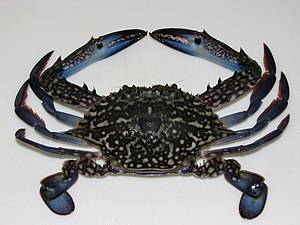Portunus pelagicus/ja: Difference between revisions
Created page with "==生態{{Anchor|Ecology}}== thumb|オスの''Portunus pelagicus''は[[:en:territoriality|縄張り意識が強いことがある。]] ''P. pelagicus''は餌と隠れ家を求めて汽水域に頻繁に入り込む。そのライフサイクルは汽水域に依存しており、幼生や初期の稚ガニは成長と発達のためにこれらの生息地を利用する。孵化に先立ち、..." |
Created page with "==漁獲{{Anchor|Capture}}== thumb|[[:en:Food and Agriculture Organization|FAOが報告した、1965年から2022年までの''Portunus pelagicus''の世界漁獲量(千トン単位)]] この種はインド太平洋地域で商業的に重要であり、伝統的な硬い殻のまま、またはアジア中で珍味とされる「ソフトシェル」として販売さ..." |
||
| Line 17: | Line 17: | ||
彼らはほとんどの時間、特に日中や冬の間は砂や泥の中に埋まって過ごす。この習性が、[[ammonium/ja|アンモニウム]](NH<sub>4</sub><sup>+</sup>)や[[ammonia/ja|アンモニア]](NH<sub>3</sub>)に対する高い耐性を持つ理由かもしれない。満潮時に出てきて、二枚貝、魚、そして少量ではあるが大型藻類など、様々な生物を捕食する。パドルのような扁平な脚を持つため、泳ぎは非常に得意である。しかし、別のイワガニ科のカニ(''[[Scylla serrata/ja|Scylla serrata]]'')とは対照的に、長時間水から出て生きることはできない。 | 彼らはほとんどの時間、特に日中や冬の間は砂や泥の中に埋まって過ごす。この習性が、[[ammonium/ja|アンモニウム]](NH<sub>4</sub><sup>+</sup>)や[[ammonia/ja|アンモニア]](NH<sub>3</sub>)に対する高い耐性を持つ理由かもしれない。満潮時に出てきて、二枚貝、魚、そして少量ではあるが大型藻類など、様々な生物を捕食する。パドルのような扁平な脚を持つため、泳ぎは非常に得意である。しかし、別のイワガニ科のカニ(''[[Scylla serrata/ja|Scylla serrata]]'')とは対照的に、長時間水から出て生きることはできない。 | ||
==漁獲{{Anchor|Capture}}== | |||
==Capture== | [[File:Blue swimming crab capture production thousand tonnes 1965-2022.svg|thumb|[[:en:Food and Agriculture Organization|FAO]]が報告した、1965年から2022年までの''Portunus pelagicus''の世界漁獲量(千トン単位)]] | ||
[[File:Blue swimming crab capture production thousand tonnes 1965-2022.svg|thumb| | この種はインド太平洋地域で商業的に重要であり、伝統的な硬い殻のまま、またはアジア中で珍味とされる「[[soft-shell crab/ja|ソフトシェル]]」として販売されることがある。この種は''[[Callinectes sapidus/ja|Callinectes sapidus]]''の代替品として高く評価されている。ペルシャ湾では、この種は肉の消費のために集中的に、かつほぼ独占的に漁獲されており、メスはオスよりも高値で取引されている。 | ||
<div lang="en" dir="ltr" class="mw-content-ltr"> | <div lang="en" dir="ltr" class="mw-content-ltr"> | ||
Revision as of 21:10, 24 June 2025
| Portunus pelagicus/ja | |
|---|---|

| |
| オス | |
| Scientific classification | |
| Domain: | Eukaryota |
| Kingdom: | Animalia |
| Phylum: | Arthropoda |
| Class: | Malacostraca |
| Order: | Decapoda |
| Suborder: | Pleocyemata |
| Infraorder: | Brachyura |
| Family: | Portunidae |
| Genus: | Portunus |
| Species: | pelagicus
|
| Binomial name | |
| pelagicus | |
| Synonyms | |
| |
タイワンガザミ, 別名blue crab、blue swimmer crab、blue manna crab、そしてflower crabは、インド太平洋に生息する大型のカニの一種である。インドネシア、マレーシア、タイ、フィリピン、ベトナムの沿岸沖、またオーストラリアのほとんどの地域および東はニューカレドニアまでの汽水域に生息している。
概要
オスは鮮やかな青色に白い斑点があり、特徴的に長い鋏脚を持つ。一方、メスはくすんだ緑/茶色で、より丸みを帯びた甲羅を持つ。甲羅の幅は最大20cmになることがある。
行動

彼らはほとんどの時間、特に日中や冬の間は砂や泥の中に埋まって過ごす。この習性が、アンモニウム(NH4+)やアンモニア(NH3)に対する高い耐性を持つ理由かもしれない。満潮時に出てきて、二枚貝、魚、そして少量ではあるが大型藻類など、様々な生物を捕食する。パドルのような扁平な脚を持つため、泳ぎは非常に得意である。しかし、別のイワガニ科のカニ(Scylla serrata)とは対照的に、長時間水から出て生きることはできない。
漁獲

この種はインド太平洋地域で商業的に重要であり、伝統的な硬い殻のまま、またはアジア中で珍味とされる「ソフトシェル」として販売されることがある。この種はCallinectes sapidusの代替品として高く評価されている。ペルシャ湾では、この種は肉の消費のために集中的に、かつほぼ独占的に漁獲されており、メスはオスよりも高値で取引されている。
These characteristics, along with their fast growth, ease of larviculture, high fecundity, and relatively high tolerance to both nitrate and ammonia, (particularly ammoniacal nitrogen, NH3–N, which is typically more toxic than ammonium, as it can more easily diffuse across the gill membranes), makes this species ideal for aquaculture.
The species is commercially fished in Australia, and is also available to recreational fishers and is regulated by various state governments. Relevant recreational fishing regulations for Australia (as of March 2016) are tabled below.
| State | Minimum carapace | Bag limit | Boat limit | Possession Limit | Notes |
|---|---|---|---|---|---|
| South Australia | 11 cm | 20 (Gulf St Vincent) or 40 (combined with sand crabs) | 60 (Gulf St Vincent) or 120 (combined with sand crabs) | N/A | |
| New South Wales | 6 cm | 10 | N/A | 20 | |
| Western Australia | 12.7 cm | 20 or 10 (West Coast) | 40 or 20 (West Coast) | N/A | Cockburn Sound is closed. Peel-Harvey Estuary is closed from 1 September to 31 October. |
| Queensland | 11.5 cm | No limit | No limit | No limit | |
| Northern Territory | N/A | N/A | N/A | 30 | Combined total for any crab species other than mud crabs. |
生態

P. pelagicusは餌と隠れ家を求めて汽水域に頻繁に入り込む。そのライフサイクルは汽水域に依存しており、幼生や初期の稚ガニは成長と発達のためにこれらの生息地を利用する。孵化に先立ち、メスは浅い海洋生息地に移動して卵を放出し、孵化したばかりのゾエアI幼生が汽水域に移動する。この間、彼らは微細なプランクトンを餌とし、ゾエアI期からゾエアIV期(約8日間)、そして最終幼生期のメガロパ(4〜6日間)へと進行する。この幼生期は、獲物を捕獲するために使われる大きな鋏脚を持つことが特徴である。メガロパがカニの段階に変態した後も、彼らは汽水域で過ごし続け、そこは隠れ家と餌に適した生息地を提供する。しかし、初期の稚ガニが低塩分濃度に長時間耐えられないという証拠があり、これはその弱い高浸透圧調節能力のためと考えられる。このことが、雨季に彼らが汽水域から海水へ大量に移動する理由を説明するかもしれない。オスのPortunus pelagicusは、冷たい水中でより縄張り意識が強くなると考えられている。このため、温暖な水域ではオスのカニが互いに接近して目撃されることが稀である理由が説明できる。また、これらの地域でメスの方がより多く見られる理由も説明できるかもしれない。
文化的意義
このカニの動きは、フィリピンのセブ州カルカル発祥のLinambayというモロモロの一種における舞踊のステップと動きの基礎となっている。現地ではこのカニは「Lambay」と呼ばれている。
| この記事は、クリエイティブ・コモンズ・表示・継承ライセンス3.0のもとで公表されたウィキペディアの項目Portunus pelagicus(19 June 2025, at 23:15編集記事参照)を翻訳して二次利用しています。 |